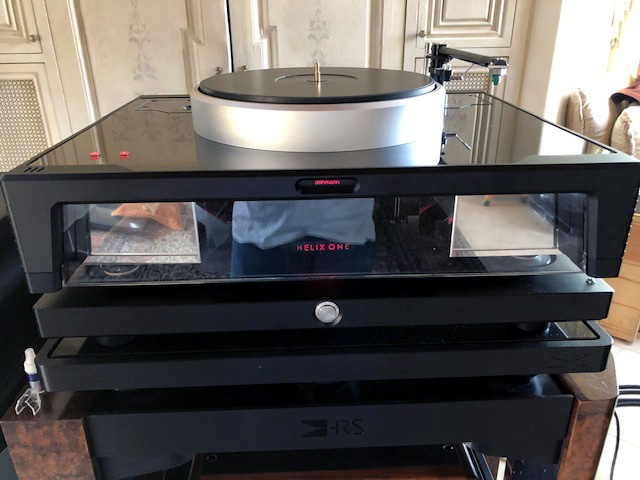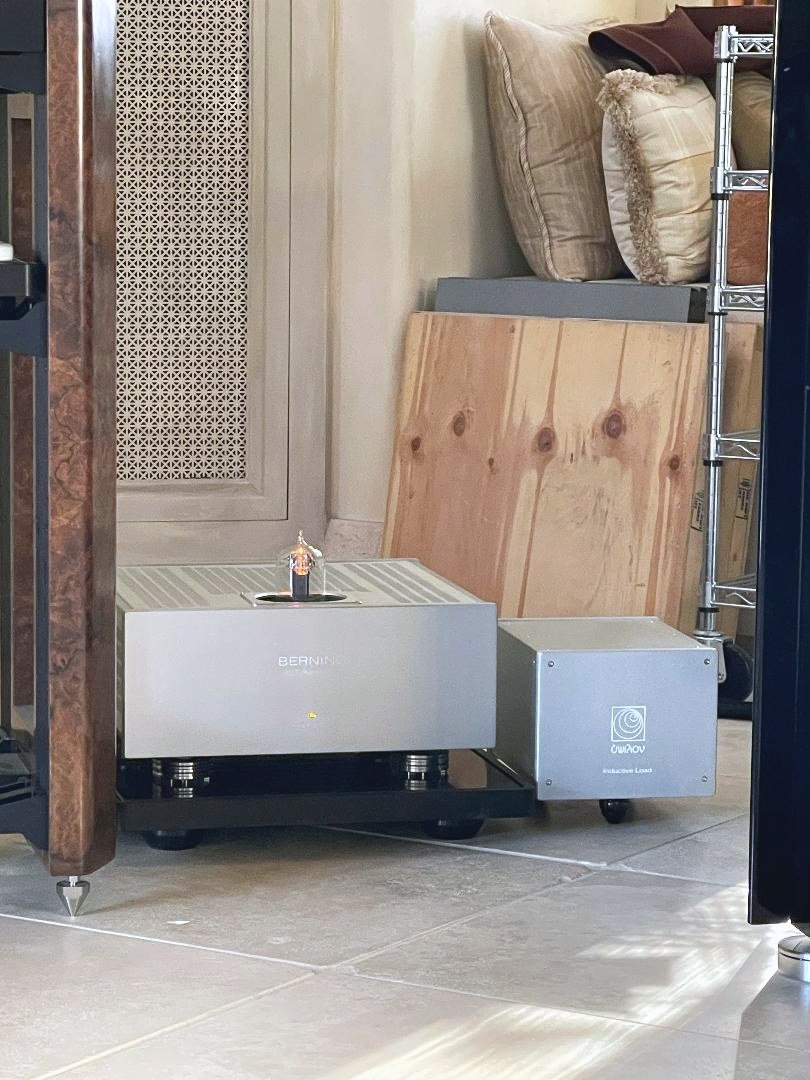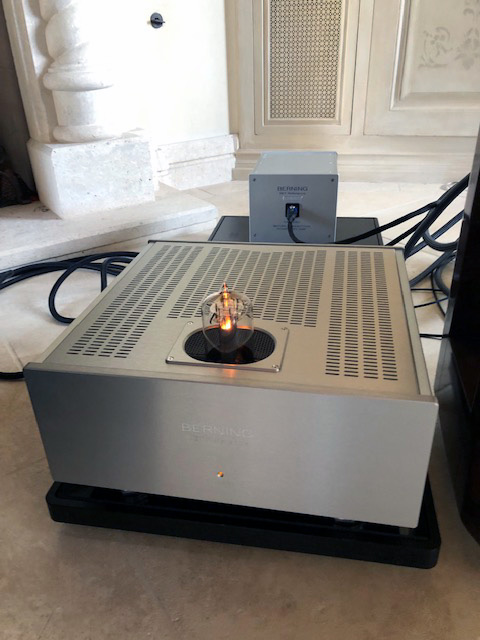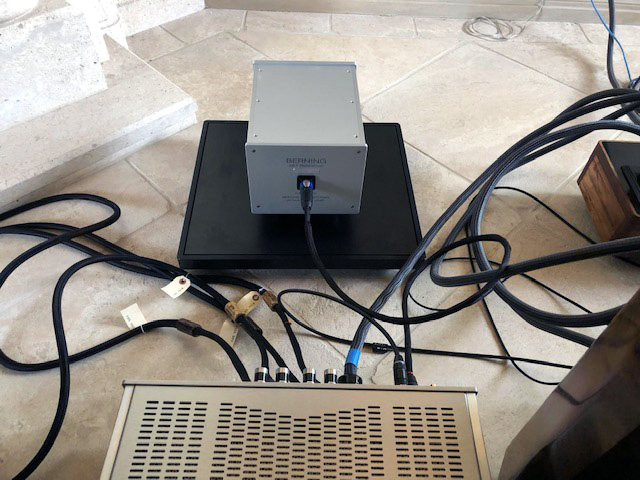The Supporting Cast
While I have initially focused on the Spharon, they are merely one part of the equation —certainly of key importance but not in and of themselves sufficient to achieve this level of performance. The key is the supporting cast of equipment, power cords and cables, and the care with which they have been assembled. This is a system that has been assembled with great care, where each component not only does its part but also works superbly with the other pieces. The whole is significantly better than the sum of its parts. For this reason, I want to spend some time talking about the supporting cast starting with the amp and preamp.
The Berning SET amp is the result of a lengthy collaboration led by Rick Brown, David Berning (the lead amplifier designer), Demetrius Backlavis of Ypsilon, and Steve Mc Cormack of SMc Audio over a three-year period. The SET is based on the latest iteration of Berning’s 1996 patented breakthrough ZOTL technology. It matches the high impedance of tubes to the low impedance of speakers without an audio output transformer. Traditional SET amplifiers with an output transformer are not linear at the frequency extremes. The design of the Berning SET solves this conundrum.
Steve McCormack’s understanding of materials science drove Panzerholz and aluminum main chassis design and mechanical grounding construction techniques. Steve and Rick did final voicing of the amplifiers. Forty-five-pound silver wire-wound inductors are sourced from Ypsilon and externally connected by Enklein umbilical cables. The result is a single ended triode based around a 211 or 845 tube (switchable without adjustment) provided by Elrog in Germany. The amplifier is output transformerless, zero feedback and self-biasing. It delivers 18 watts class A triode and is supposed to drive even relatively low efficiency speakers. Parts are simply the best available or bespoke, like milled Teflon and beryllium copper tube sockets. I was able to hear the Berning SET with copper- as well as silver-wound inductors by Ypsilon; the contribution the silver-wound artisanal inductors make cannot be overstated. They are absolutely critical.
No cost has been spared if it improves the sound and the sound is ethereal; think of the sound of the best low-wattage SET in the midrange coupled with the type of extension and power in the bass and treble that a transformer-coupled SET cannot deliver.
In turn the amps are driven by a new Steve McCormack-designed preamp, the SMC VRE-2 Hi Fi One Silver edition. Solid state, but unlike any solid-state preamp you have heard. There is extreme resolution but not at the expense of tonality and timbre.
The front end of the system consists of a Mark Dohmann Audio Helix One Mkii turntable equipped with a Schroeder CB tonearm with carbon fiber arm tube and a Lyra Atlas cartridge (setup by Mark Dohmann), running into an updated Lyra Connoisseur 4.3 SE phono stage. Initially, the turntable was used with the supplied Dohmann record weight; however, the Stillpoints record weight proved to be much superior. Digital is handled by an EMM Labs XDS1 used solely as a transport driving an EMM Labs DA2 digital to analog converter through an Enklein XerXes AES/EBU cable.
Interconnects include Enklein XerXes balanced cables and Lyra LinePipe unbalanced. Speaker cables, including the passive crossover cables, are Enklein XerXes as are all power cords. The speakers are supported by bespoke Stillpoints Ultra 7 feet, while a combination of Stillpoints Ultra 6 and RevOpod dampers support the electronics, which are sited on HRS racks and platforms.
Listening Impressions – General Comments
Sometimes you develop expectations only to find that reality is very different; not necessarily better or worse, but clearly different. I visualized the Spharon as a larger version of the Acapella Triolons, which I have owned since 2008, meaning a speaker that would go much lower with significantly more power, at the same time creating vast panoramas of sound beyond anything I was accustomed to. As it happened, the Spharon —and I must qualify this by saying that, more accurately, I really mean Jim’s system as a whole —had a different focus altogether. Certainly, the sound picture that the system created was of a very believable size. Yet, overall, Jim’s sound was about a lot more than size, or deep bass. The music that it reproduced had a certain delicacy and naturalness of tone and timbre that was so close to live music in an excellent venue as to at times be almost indistinguishable from the real thing. While the system was capable of extreme resolution, it never called attention to that. Indeed, at first hearing, the system seemed almost soft at the top; however, as I listened further, I began to realize that not only was all the detail there but I was hearing things that are inaudible on lesser systems. Not only did I hear more low-level detail and ambient cues, but I also experienced a better ability to follow complex musical lines.
In fact, it was almost funny: As large as the Spharon are— they would be the elephant in virtually any room —they disappeared (from a listening standpoint) to a degree that I’ve rarely experienced. This was particularly true in nearfield listening; in fact, nearfield became my preferred listening station with Jim’s system most of the time. From where I sat, sound never seemed to emanate from the front of the speakers or from a particular driver. The speakers, in this context, were extremely coherent, almost as if this were a single-driver system. Likewise, there is a dynamic coherence: no portion of the frequency range got louder or softer than any other, except as required by the music. I am sure that you have heard speakers where the bass (or some other narrow frequency band) seems to get louder sooner than other frequencies. Not so here. While the bass can plumb the deepest depths (at least down to 16 hertz), for the vast majority of recordings, the woofers were so well integrated with the midbass and the midrange that I did not notice them. Similarly, the treble was detailed, fast, and delicate as only a plasma tweeter can be, but to an unusual degree I was unaware of them as separate sounding entities. Midrange, particularly with voices, was glorious. Imaging varied from record to record, from intimate to large scale. And, while you might expect that speakers this large would exaggerate image size, that was just not the case.
As you might guess, this is a system that does organ music particularly well. Organ pipes through this system magically draw your head upward to the 22’ ceiling as if you were in a cathedral or large church, and the sound reverberates throughout the room accordingly. As many of us are doubtlessly aware, churches have notoriously bad acoustics, but the organ pipes nonetheless draw our attention upwards, even when they are located in the back of the church; that is how “real” the listening experience is with Jim’s system.
As one might expect, this is a system where digital media is superbly rendered, yet analog is simply on another level. It makes you understand why audiophiles hold on to vinyl records recorded 60+ years ago and treasure them. Due credit must be given to the ‘table, cartridge and phonostage . . . well, ultimately, the whole system, of course.
Listening Impressions —The Music
While this is not a review, I did want to refer to the sound of a few albums on the system, in particular:
Rossini, Overtures, Decca SXL 2266, Gamba, LSO: This is a record that I thought I had played one too many times. By the end of the first track, I realized I was wrong. It was the strings that first captured my attention. So often, strings can sound slightly hard, harsh or unrealistic. In many systems, you hear strings as an almost undifferentiated mass instead of as a group of individual players, often with an edge where it seems to be all about the attack, without the throaty follow-up. The presentation here was among the best reproductions of orchestral strings that I have ever heard, never a harsh moment, tight but clearly a group of individual players. Imaging left to right was stable and well-focused, similar to what you might hear in a good hall with a good sense of air.
Walter Piston, The Incredible Flutist, Mercury SR90206: For the Piston, I moved into a near field listening position, which had the benefit of taking the room out of the equation. This Mercury was recorded in Rochester and like others recorded there has a characteristic sound —wiry strings and, well, wiry everything else. I was startled by what the system did with this recording. The strings lost a good bit of their edge without sounding in a way that violated the actualities of the recording. A conductor friend of mine once told me that what he enjoyed about the Mercury sound was that it seemed quite a bit like what he heard in the conductor’s seat. Listening here, I understood his view exactly. I felt as if I were hearing all the voices in the orchestra and could, for the most part, pick out their locations. (Had they not been playing so well, I would not have been able to keep from correcting them as necessary!) The percussion was terrific. The bass drum was right there, but like a real bass drum, not in some technicolor audiophile dream of how bass drums should sound. Likewise, the basses and cellos were real, there when they were supposed to be there, but not otherwise. I felt a nice floor when they got busy, but not when they were quiet. Late within the piece, there is a moment with solo piano beginning on a very low note. I heard and felt that note all the way to the bottom. There was no compromise, but nothing phony either. During the “mysterious” moments of the piece when everyone is playing softly and the spotlight is on a wind instrument, everything was there, atmospheric but real. Plucked strings were wonderful to hear and feel, palpable, but again nothing was excessively demonstrative, just real.
It dawned on me that the experience was like being in the control room during immediate playback of the master tape during a recording session.
Bartok, Music for Strings, Percussion, and Celesta/Hungarian Sketches, Reiner/Chicago, RCA LSC 2374 (Shady Dog): The soundstage was very wide, even from a close listening position. Strings were clearly delineated. The clarity was remarkable (amazing when the celeste first enters, as if coming from the heavens). I did not notice a huge sense of “air’ as I sometimes do; however, I did hear the air that seemed to be part of the sound of each of the instruments as they were in play. This was especially true with percussion, from timpani to snare to cymbals. Indeed, the skin of the timpani(s) was very clearly palpable and alive. I see from my notes that, early on, as the piece opens up with percussion, celeste and piano, with the strings no longer muted, I was in particular struck with the width of the soundstage.
Greensleeves, Vaughn Williams, English Chamber Orchestra, DG 2539 505 (Delius side): While I am very fond of this record, some might think it too syrupy. One reviewer described the music of Delius as “Debussy meets the English cow-pat school.” Okay, but his harmonies are as rich and extended, tonality-wise, as the best cheesecake that you ever put in your mouth. I have been waiting for a system that could extract the most from this. This system did that. The microphones were placed up close and focused on achieving tonal density. The winds became the icing on the cake. From my notes: “Barenboim (conducting) seems to be enjoying this immensely.” And, while the strings were recorded relatively close in, they were nevertheless still spread across a wide soundstage. The winds were back in a more-or-less identifiable position, but it seemed clear that holographic imaging was not the first concern of the recording team. The first concern was sensuality, and they achieved that one hundred per cent, and that is what the strings were principally charged with doing. That became what I wanted to follow, because that was where the harmonic richness lives in these pieces (as Barenboim seemed to want us to experience). Some of the best moments later in the side came from the bottom. Delius creates tension at times with bass lines that go off in a direction that you do not expect. And on this system, they went there with vibrant authority and spaciousness. Delius likes to do similar things with inner voices, not unlike how Bill Evans did it with his chording in jazz pieces a half century later. All of those could be followed with ease. Yet, with the density of the chording (at times), the consonance filled the listening space with warmth.
Ravel, Ma Mere L’Oye (Mother Goose), Ansermet, London CS 6023 (Blueback): Having heard this recording so many times on many excellent systems, let me note some things that struck me hearing it on this system: the fullness of each solo instrument’s sound, from the initial attack down to the bottom of the tonal profile and to a sense of the floor when the bass instruments played. Curiously, depth of field in the soundstage did not generally come to my attention per se, but I had a very good sense for where the instruments were in relation to each other, and sometimes the depth of field was remarkably evident, particularly with percussion.
The full-bodied sweetness of the strings was more evident than the attack alone. This was very helpful given that Ansermet’s orchestra can sound wiry on occasion. The wiry sound did not utterly go away, but we did get to hear the rest of the string sound as well, which was to be preferred and was probably more accurate.
Cymbals sounded very natural, carrying both the splash and the roundness of their construction. Finally, in dense passages with many instruments playing, I got this wonderful sense of being able to hear everything, such that I could concentrate my focus wherever I wished, without losing track of the full context.
Conclusion
Over the almost fifty years that I have been an audiophile, I have attended many audio shows, visited many dealer showrooms and heard many systems. I can only remember four instances where I was left speechless by what I heard: the Levinson HQD (Hartley 24” subs, double Quad 57 electrostatic speakers and Decca ribbon tweeters); the Acapella Campaniles at CES in Las Vegas at the Tuscany in 2002, driven by an Audio Aero Capitole tube amp; highly modified Spectral electronics driving Crosby modified Quad 57’s and Entec subwoofers; and, strangely enough, the smaller Magnepans driven by Jadis JA-30 amps. Jim’s system clearly and by a rather large margin surpasses any of these.
As one of the other listeners commented:
“The ability of the system to reproduce a piano, a drum kit’s explosive high hat hits, pipe organ and full-scale orchestra is as good as I have experienced. I came away from my initial listening session with goose bumps covering my arms. It is that powerful; however, the real glory of the system is at low to very low listening levels. The way that solo instruments and voices are floated in front of you with presence, solidity, weight, full range dynamics and stable stage dimensions is extremely impressive. Its only equal in the midrange is the original Quad 57 which had its own limitations. The speakers have a tonal beauty, richness and image density that is impossible to forget once experienced.”
I don’t know if my friend Jim will stop here in his journey. But, frankly, for my ears, I believe that I would find this an easy resting place, a place where the main limitation is going to be in the recordings, going forward, not in their reproduction.
I should say, too, however, that after traveling back to my home and listening to my own system, I find that I am, relatively, content with the sound that I have, although I will, no doubt, continue my tinkering, trying to get it better. The focus of my system is somewhat different. Jim says about his own preferences that he wants to hear what the microphones hear. I am more inclined toward a sound that gives me the illusion of being in a concert hall, perhaps 10 or 12 rows from the front. So, while Jim is in the control room of the studio, I am in Row J or K. I can certainly appreciate and enjoy being in the control room with Jim, and I think conversely, he can appreciate and enjoy the concert hall illusion as well; but it is nice to be home.
Acapella Audio Arts is distributed in USA by Audio Federation, Palo Alto, CA.
Copy editor: Dan Rubin
- ← Previous page
- (Page 2 of 2)






Amazing room and system. I don’t pretend to understand even 10% of the technical discussion, but I thoroughly enjoyed this piece. Wonderfully descriptive and engaging writing — I felt like I was in the room.
Technical discsussion? I didn’t see one
Thank you so much for the positive comments. My hope is that I was successful in passing along my enthusiasm for this system and my respect for its owner. Jim continues tweaking the system with some success. This is more fine tuning than anything else.
I have a couple of questions. First, how does it sound with acapella’s own lamusika amplifier and mono rear stage? Second, would it be better to use fm acoustics 268c/1811? Third, this sound system is supposed to be the top of the world. I wonder how it compares to the fm acoustics inspiration xs1-c/268c/1811 set?
Good questions to which I unfortunately do not have the answers. By the time of my visit, the amps provided by Acapella as part of the package had been disconnected so I did not hear them. I am convinced that the Berning SET amps were a perfect match for these speakers. With respect to FM Acoustics, I have great respect for their products but have not heard their current line-up so cannot offer an informed opinion.
Given that this is a “consideration” rather than a review and that it focused on the whole system, I did not do a technical discussion. If I get individual pieces for review, I will do a technical discussion of that piece.